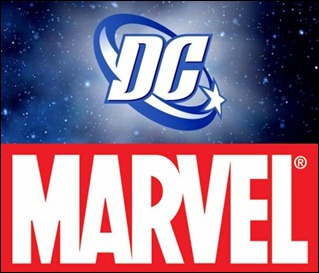Recently I was having a conversation with a friend who had read comics years ago, but hasn’t picked one up in a long time. We had just come from a local comic shop where I picked up a few books I was missing and told me that he was overwhelmed by the amount of titles that were being published and didn’t know what to buy. He likes the X-Men, but there are too many X-Men titles to choose from, and on top of that, he didn’t want to get anything that was in the middle of a storyline. Having to pick up #1-10 of a series that was on issue #11 wasn’t what he wanted either.
This is one of the hurdles that the industry has to overcome. Only through the efforts of publishers, retailers, and fans, can this be accomplished effectively.
One problem with the marketing strategy of the Big Two (Marvel & DC) publishers is their reliance on restarting a series in order to increase sales. Surely it will increase short term sales because people love to get in on a ‘first’ issue of a series, but that ‘first issue,’ more often than not, is just a different storyline that could have been continued in the previous title.
You don’t always have to change the numbering when something drastic happens, just indicate it on the cover and make sure your audience is aware. If this ideology of “Number One’s always sell well” becomes the status quo, why would we ever need a series to go more than 15 issues, or 20, or 25? Do we need 10 different Flash #1’s or 15 different Wolverine #1’s? No. Lately, though, it seems like we’re moving in that direction. Does every change to a new creative team require a restart of a current series? Does a major change to a character need to have the series cancelled and retitled? I hope the answer to those, and similar questions, is no.
So back to the conversation we had… I told my friend he should just pick a character or title he likes, open up an issue, and look at the title. Usually in the title there is an indication of what part of the story they’re on and grab the first part of that story and go from there. Most titles have a “previously on…” intro to get you up and running on the action. If he’s really not sure of what’s going on, there are so many resources online now like comicvine, that he can get completely caught up on any and all of the backstory.
The industry needs more of this and less of a reliance on 1st issues to increase sales, thus creating a healthier future market. Removing that ‘collector’s mentality’ – that quite often bleeds consumer sales once the title reaches #6 or higher – helps stabilize the fluctuation in sales caused by it. Like a drug, the more it’s used by the marketplace, the more reliant that market is on it’s continuation.
What needs to be done, by publishers, responsible comic shop owners, and current readers alike, is to educate new or non-readers that they can just pick up a book and start reading. They don’t NEED to wait until the next #1, or the next  mini-series, to get enjoyment out of a story currently in progress. With the advent of so many reprint collections and comics websites, there’s no reason why anyone couldn’t get all the backstory they needed.
mini-series, to get enjoyment out of a story currently in progress. With the advent of so many reprint collections and comics websites, there’s no reason why anyone couldn’t get all the backstory they needed.
When I was young, I would pick up an issue in mid-run and fill in the blanks as much as I could until I knew what was going on. It never ruined my enjoyment of a story, even though I picked it up after it had started. Why should new readers feel any different that those of us in the past?
Marvel and DC need to realize that constantly and continuously restarting a series is bad for the marketplace in the long term. This is a trend that Marvel seems to  have embraced in the mid-1990’s and has been perpetuating it since.
have embraced in the mid-1990’s and has been perpetuating it since.
A story can have a dramatic impact on a title, or a character on a team can die without the cancellation and restart of a book. Of course there are always some exceptions to the rule, but most restarts are unnecessary. By advertising a big change in a series and by indicating it on the cover, publishers can get the news out so people will know what to buy and when to look for it. Also you don’t necessarily need to add a .1 to the title to get that point across. 
Uncanny X-Men wasn’t cancelled with issue #138 after the Phoenix died and Cyclops left. Green Lantern wasn’t cancelled when Hal Jordan became Parallax. Batman wasn’t restarted after Robin (Jason Todd) was killed in issue #429. So why should today be any different? Desperation and short-sightedness in this ever shrinking market has led publishers to embrace and perpetuate this idea of ‘creating more #1’s will increase the market.”
Also flooding the market with so many event tie-in and crossovers just confuses perspective new customers when they enter a shop. DC has their Flashpoint mini-series and Marvel has their Fear Itself tie-ins and crossover mini-series that can take up several racks all by themselves. If a new consumer feels like they’ll be lost without having to shell out a lot of money and dedicate the next 4-6 months on books they might not even enjoy, they’ll walk out without buying anything. But that’s a topic for another time.
Publishing a continuing CORE line of titles with mini-series, Annuals, and one-shots is a lot less daunting, for a new purchaser along with the long term fan, than the system we have in place now.
Image Comics’ The Walking Dead has steadily increased sales over the last four years and the series is up in the 80’s in numbering. They didn’t need to restart the series with the popularity of the TV series, yet sales have increased. Whereas Wolverine was restarted last year and it lost almost 60% of it’s sales from #1 to #9.
 According to Diamond’s May 2011 sales figures, Wolverine #9 is ranked #31 with sales of 44,635 copies and Walking Dead #85 is ranked at #40 with 37,552 copies sold. The latter after 85 issues is doing almost as well as a ‘popular’ series that’s not even a year into it’s re-started series. Constant restarts wear down the audience over time and make them jaded to publishers’ marketing schemes.
According to Diamond’s May 2011 sales figures, Wolverine #9 is ranked #31 with sales of 44,635 copies and Walking Dead #85 is ranked at #40 with 37,552 copies sold. The latter after 85 issues is doing almost as well as a ‘popular’ series that’s not even a year into it’s re-started series. Constant restarts wear down the audience over time and make them jaded to publishers’ marketing schemes.
This industry needs to grow, and it’s primed to grow NOW. All the TV series based on comics, all the superhero films being made, and all the animated DVDs that are being released are creating a potential influx of new readership. The Big Two need to concentrate more on how to tap that market, and less time trying to figure out how to get more first issues on the stands.
– The Comic Book Critic



Actually in our experience, most non-collector or casual readers are unaware of the numbering on comics and when they are, they find it has little importance. The problem is not numbering or re-numbering, it’s exposure and competiton. Those are the true obstacles in growing the comic market, IMO.
Yup. Exposure and competition for mindshare. We are up to our eyeballs in entertainment content to be consumed.
I also think that exposure is a key point in growing the market. The problem is that comics still cling to this stigma that they’re mainly for kids or people who are viewed as “not quite mature.” This is a shame. Of course we know that’s a lot of bull, but the mainstream still has that skewed perception.
It’s going to require a lot of effort and mainstream media support to get perceptions to change. Until then we’re in a very niche market that seems to be shrinking little by little. This medium offers so much potential for storytelling and yet a lot of people shun it.
I know that I’ll keep pushing people I know towards comics and if others did the same, we’d be in a much more sustainable marketplace.
Fascinating. I enjoyed your prose on how the marketing strategy affects new readers. I agree. There really should be two marketing strategies. One aimed at the die hard fan, and another focused on reeling in the new comic book readers. I was hoping for a deeper discussion on the digital platform.
I’ve got a few more posts in the works. One being how digital distribution *could* play itself out, and another on starting an initiative in which readers can introduce new readers into the market. Hopefully I’ll have time soon to actually flesh out those ideas in type :)
Awesome. The ‘readers introducing new readers’ initiative completely arrested my attention. I simply cannot wait to read that one.
Consider yourself officially added to my Google Reader :D And I TOTALLY understand about getting hands to keyboard. Trust me. The life of a writer.
Thanks for the kind words! I just want to help bring the comics market into sustainability, in whatever form I can. I can bitch and moan all I want about how this doesn’t work and how that is bad, but I’m trying to come up with ideas to help the marketplace. I’m not saying that I’m right, but sometimes you have to throw ideas out there and see if any of them stick. :)
I completely agree. I would also stress the importance of synergy. Full out corporate culture isn’t necessary, but I feel a consistent shopping experience is. All it takes is one initial bad experience to turn off a person who has travelled all the way to their local store. Comic readers and retailers must be more inclusive and goodwill ambassadors and have gateway comics to do it with.
The best retailers are friendly, engaging, and know their product. From there, once you know your customers, you can build a steady and interactive experience that makes them comfortable in your store. I used to own and manage a store for almost 8 yrs. 90% of the time I could greet a steady customer and hand them a book that they never read, but knew they would enjoy and buy. If they had a limited budget, I’d tell them “don’t buy those, here buy these.” That’s what we need in this industry – people who care and are willing to help.